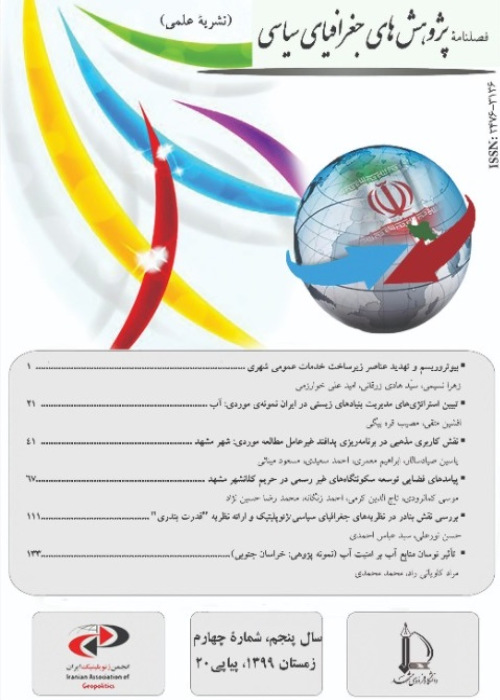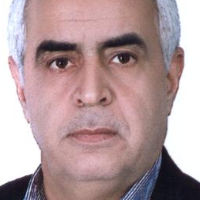Identification and Spatial Analysis of Crime Hotspots Robbery in Mashhad Metropolis
Author(s):
Article Type:
Research/Original Article (دارای رتبه معتبر)
Abstract:
Introduction
Today, robbery, as one of the most widespread and abusive kinds of crime in most of the countries including Iran, has become a widespread and serious problem that has various social, economic and security dimensions. Over the past few decades, with the advent of advanced tools, crime mapping has become a major issue for scholars and thinkers in analyzing and distributing geographic spatial distribution of crime, in order to examine the spatial perception of criminals with greater spatial accuracy. Crime analysis, and in general, geographic crime studies look for spatial representation of criminal acts to know how to disperse crime, and identify mass crime cores. The main purpose of this kind of attitude and analysis of crime is to provide patterns to reduce the incidence of crime in the urban space. Studies show that some urban spaces have higher rates of crime due to their physical, social and economic characteristics, and vice versa, some spaces prevent and deter crime within themselves. On the other hand, it has been proven that criminal offenders often make logical choices and seek the simplest, least risky and most suitable opportunities and conditions for the time and place for committing crime. Accordingly, the study intends to identify and analyze the spatial masses of burglaries in the Mashhad metropolis.
Therotical Framwork
Theft is to steal something secretly. The crime center is the area where the average crime rate is more than the periphery. This place can be a house, a street corner, a shop or any other place.Unprotected urban spaces are areas of cities that are more suitable for crime than other physical urban areas. The occurrence of crime in one place produces an outline map, in which the spatial distribution of offenses is well represented. It also shows the flow of basic crime patterns in the region. Time-based patterns of crime can be displayed seasonally, monthly, weekly, and day-to-day. The most important spatial patterns of crime are as follows: A) Scattered pattern: In this pattern, crime is spread throughout the study area and is not clustered or concentrated like the status of houses that are located across the scope of the robbery due to the inadequate design features of these locations. B) Cluster Pattern: These types of criminal events are clustered in one or more special spaces within the scope of the study. For example, sports stadiums can be be the focus of a myriad of offenses related to vehicles. C) Point pattern: This particular type of crime conforms to a particular criminal location. For example, shopping mall parkings in the center of a busy city can be of such kind where all delinquency events are created in a special place.
Method
The method of research in this research is purposeful, applied and descriptive-analytical. ArcGIS and Surfer softwares were used to analyze the data. The statistical population of the study, including theft crimes, occurred in the time period from 2011 to 2016 (9152 cases) in Mashhad, the information was obtained from the awareness police of Khorasan Razavi province.
4 .Results and Discussion
The results of the research show that between 2011 and 2016, the highest rate of theft occurred was in the year 2015 and the lowest rate was in the year 2012. Among the areas of Mashhad, zone 11 of Mashhad with 0.26% in 2015, the lowest level of theft and zone 2 with 17.16% in 2011, has the highest rate of robbery. Also, the highest rate of robbery is in Samen area. The results of the standard deviation test indicate that the depth and direction of development of theft in the city of Mashhad stretch from the northwest towards the southeast. After investigating the spatial distribution of high crime scenes during 2011-2016, Khawja Rabih area was identified as the main center for theft.
5 .Conclusion
In the new millennium, due to the expansion of urbanization and the emergence of metropolitan areas, a variety of urban issues including increased crime rates have become particularly evident. Crime is a phenomenon in which human beings with all the facilities and scientific advancements have not been able to control it and increase it.. In fact, delinquency is a very complex social phenomenon that can be seen in different social environments. The source of delinquency must be sought in the social and economic structures and the disadvantages they derive from them. In the case of a spatial and temporal context, the grounds for crime and its repetition are provided, and over time, a geographic environment becomes a mass crime center.The results of the present study show that corrupt crime pillars in Mashhad are often located in defenseless urban spaces such as marginalized areas and worn out texture. Thus, plans must be made to control and reduce crime in these areas.Keywords:
Hotspot , Crime , Robbery , GIS , Mashhad city
Language:
Persian
Published:
Research Political Geography, Volume:2 Issue: 4, 2018
Pages:
21 to 46
magiran.com/p2007203
دانلود و مطالعه متن این مقاله با یکی از روشهای زیر امکان پذیر است:
اشتراک شخصی
با عضویت و پرداخت آنلاین حق اشتراک یکساله به مبلغ 1,390,000ريال میتوانید 70 عنوان مطلب دانلود کنید!
اشتراک سازمانی
به کتابخانه دانشگاه یا محل کار خود پیشنهاد کنید تا اشتراک سازمانی این پایگاه را برای دسترسی نامحدود همه کاربران به متن مطالب تهیه نمایند!
توجه!
- حق عضویت دریافتی صرف حمایت از نشریات عضو و نگهداری، تکمیل و توسعه مگیران میشود.
- پرداخت حق اشتراک و دانلود مقالات اجازه بازنشر آن در سایر رسانههای چاپی و دیجیتال را به کاربر نمیدهد.
دسترسی سراسری کاربران دانشگاه پیام نور!
اعضای هیئت علمی و دانشجویان دانشگاه پیام نور در سراسر کشور، در صورت ثبت نام با ایمیل دانشگاهی، تا پایان فروردین ماه 1403 به مقالات سایت دسترسی خواهند داشت!
In order to view content subscription is required
Personal subscription
Subscribe magiran.com for 70 € euros via PayPal and download 70 articles during a year.
Organization subscription
Please contact us to subscribe your university or library for unlimited access!



